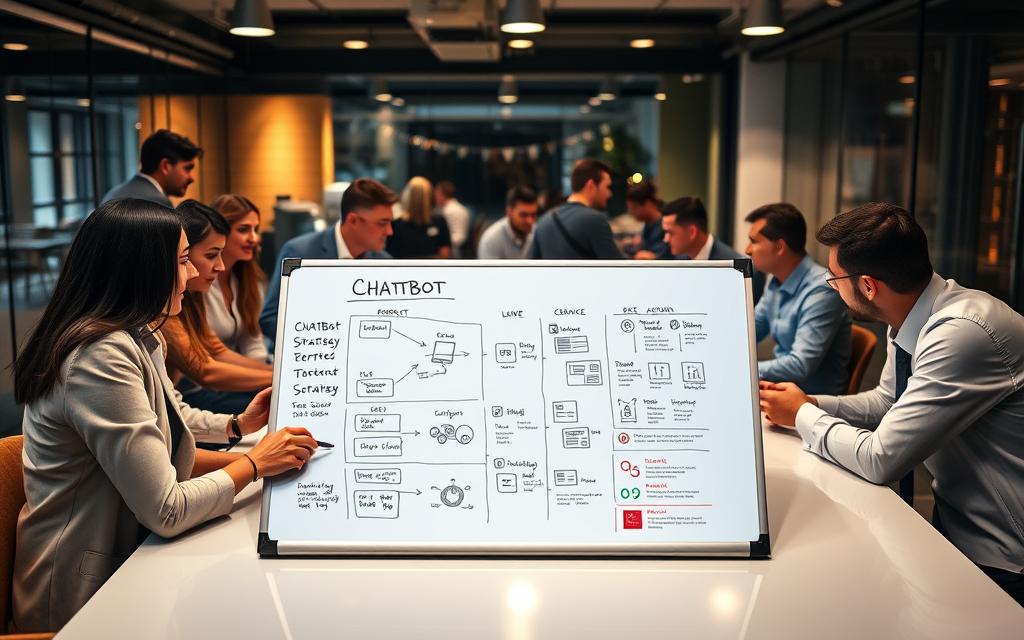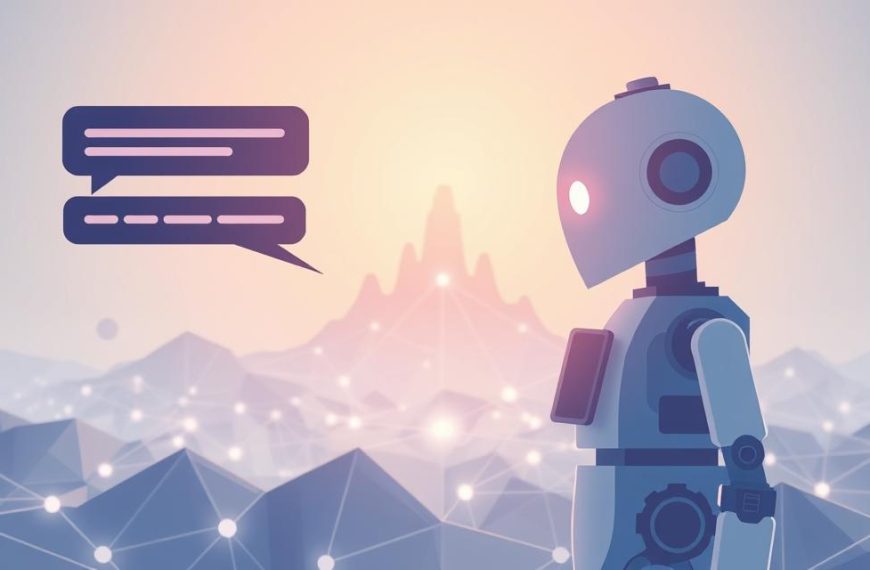In today’s fast-paced business world, leveraging technology is essential for staying competitive. One powerful tool gaining traction is the use of chatbots. These AI-powered solutions are transforming industries like healthcare, finance, and e-commerce by streamlining operations and enhancing customer experience.
The global chatbot market was valued at $430 million in 2020 and is projected to grow at a 24.9% CAGR through 2028. This growth highlights the increasing demand for efficient implementation of these tools. For example, Valley Driving School achieved a 94% satisfaction rate by automating shipping and returns processes with chatbots.
However, poor execution can lead to frustrated customers and decreased ROI. To avoid these pitfalls, focus on key components like audience analysis, persona design, and platform selection. A well-planned chatbot strategy ensures your business stays ahead in the digital age.
Understanding the Basics of a Chatbot Strategy
Building a robust chatbot strategy starts with mastering its core components. These elements ensure your solution aligns with your brand and meets the needs of your target audience. Without a solid foundation, even the most advanced technology can fall short.
Core Components of Effective Implementation
To create a successful chatbot, focus on these four essential elements:
- Goal Alignment: Define clear objectives that support your business needs.
- Persona Development: Design a chatbot personality that resonates with your audience.
- NLP Integration: Use natural language processing to enhance user interactions.
- Analytics: Track performance to refine and improve over time.
According to Gartner’s “sophistication continuum,” chatbots fall into two categories: transactional and generative AI. Transactional bots handle specific tasks, while generative AI offers more dynamic, human-like responses. Choosing the right type depends on your goals and customer journey.
PwC research reveals that 82% of consumers prefer human interaction alongside technology. Yet, 60% feel brands often neglect the human experience in tech implementations. Balancing automation with a personal touch is crucial for success.
For example, in the travel industry, chatbots can map the customer journey by providing real-time updates and personalized recommendations. Similarly, Sideshow Collectibles created a branded droid persona that seamlessly hands off conversations to human agents when needed. These examples highlight the importance of thoughtful design and integration.
The Importance of a Chatbot Strategy for Your Business
Adopting advanced technology can transform how businesses interact with customers. A well-designed approach ensures seamless communication, improved efficiency, and enhanced customer service. By focusing on clear objectives, companies can unlock the full potential of automation.
One of the key benefits is cost reduction. Studies show that implementing intelligent solutions can cut contact center expenses by 59%. This is achieved through 24/7 availability and efficient handling of routine inquiries.
Competitive Advantages & Operational Efficiency
Proactive chat invitations can boost lead generation by 6x. This demonstrates how a successful chatbot can drive conversions. In healthcare, automated appointment scheduling reduces no-shows by 22%, improving patient care and resource utilization.
Retailers also benefit significantly. Timely nudges from bots recover 18% of abandoned carts, increasing revenue. IBM recommends designing bots that recognize their limitations, which improves customer service satisfaction by 31%.
| Industry | Use Case | Impact |
|---|---|---|
| Healthcare | Appointment Scheduling | 22% Reduction in No-Shows |
| Retail | Cart Recovery | 18% Increase in Sales |
| Contact Centers | Deflection | 59% Cost Reduction |
By integrating these tools, businesses can streamline operations, reduce costs, and deliver exceptional experiences. The right strategy ensures long-term success in a competitive market.
Identifying Your Business Goals for Chatbot Implementation
Clear objectives are the foundation of any successful automation initiative. Without well-defined goals, even the most advanced technology can fall short. Start by identifying the specific issues your business aims to address, whether it’s reducing customer service tickets or improving lead qualification.
One effective method is the Miro board approach. This visual tool helps prioritize problems and align them with potential solutions. For instance, shipping FAQs might require immediate attention, while lead qualification can be a secondary focus. This structured analysis ensures your chatbot platform addresses the most pressing needs.
Aligning AI with Organizational Objectives
Establishing a goal hierarchy is crucial. Begin with reducing tickets, then aim to improve customer satisfaction (CSAT), and finally boost conversions. This step-by-step approach ensures measurable progress and long-term success.
For example, e-commerce businesses have seen a 17% increase in cart recovery rates using abandoned cart triggers. Similarly, intent-based scripting has reduced resolution times by 40%, enhancing customer experiences.
Key performance indicators (KPIs) provide benchmarks for success. Aim for 90% first-response accuracy and resolution times under two minutes. These metrics ensure your solution delivers tangible results.
| Application | Use Case | Impact |
|---|---|---|
| B2B | Lead Scoring | Improved Lead Quality |
| B2C | Product Recommendations | Higher Conversion Rates |
By aligning AI with your strategy, you can address specific challenges and achieve measurable outcomes. Whether in B2B or B2C, the right approach ensures your business stays competitive in the digital age.
Analyzing Your Target Audience for Chatbot Success
Understanding your target audience is the cornerstone of any successful automation tool. By identifying their preferences, pain points, and behaviors, you can design a solution that truly resonates. Start by creating detailed personas that reflect your users’ demographics and psychographics.
Demographic & Psychographic Profiling
Persona creation involves five key steps: age clusters, tech literacy levels, pain points, preferred communication styles, and specific needs. For instance, Gen Z users often prefer emoji and GIF-friendly interactions, while Baby Boomers value clear calls-to-action and straightforward language.
In the banking sector, this approach is critical. Mortgage bots cater to first-time homebuyers by simplifying complex processes, while fraud alert systems address security concerns for tech-savvy customers. Tailoring your solution to these distinct needs ensures higher engagement and satisfaction.
Global audiences require additional considerations. Multilingual support is essential for reaching diverse users. Studies show that 73% of people prefer bots offering multiple response channels, including voice and text. Additionally, incorporating audience-specific humor can boost satisfaction rates by 68%.
By aligning your tool with the target audience’s preferences, you create a seamless and enjoyable experience. This not only enhances user satisfaction but also drives long-term success for your business.
Mapping the Customer Journey for Effective Chatbot Integration
To maximize the potential of automation, understanding the customer journey is essential. By identifying key touchpoints, businesses can create seamless interactions that enhance the overall experience. This approach not only improves efficiency but also builds trust and loyalty.
For example, journey-mapped bots resolve issues 33% faster by anticipating user needs. In the travel industry, bots like those at the Louvre provide personalized recommendations based on detected interests. These steps ensure users feel valued and supported throughout their experience.
Touchpoint Optimization Strategies
Effective integration involves optimizing every interaction. Here are key strategies to consider:
- Post-Purchase Journey: From delivery updates to returns and feedback loops, bots can streamline the entire process.
- Hospitality Case: After booking, bots can suggest visits to nearby attractions like the Musée d’Orsay.
- Real-Time Integration: API connections enable bots to send timely alerts, such as flight delays.
- Proactive Interventions: Proactive bots improve Net Promoter Scores (NPS) by 28%.
- Enterprise Sales Cycles: Bots can nurture leads or schedule instant demos, depending on the stage of the journey.
By focusing on these steps, businesses can create a cohesive and engaging experience. This not only saves time but also ensures every conversation adds value to the user’s journey.
Designing a Chatbot Persona That Aligns with Your Brand
Crafting a chatbot persona that reflects your brand identity is essential for user engagement. A well-designed persona ensures consistency, builds trust, and enhances the overall experience. By focusing on tone, language, and personality, you can create a solution that resonates with your users.
Personality Engineering Techniques
Developing a chatbot persona involves careful consideration of several factors. Start by defining the tone that aligns with your brand. For example, a formal tone suits banking, while a casual approach works better for eSports. Naming conventions also matter—opt for clear, descriptive names like “TexBot” rather than misleading human names.
Visual mascots can significantly improve retention. A/B tests show a 27% increase in user engagement when bots include visual elements. Additionally, error messages should be friendly and relatable. Phrases like “Hmm, I’m tangled!” outperform generic apologies, creating a more human-like interaction.
- Formal vs. Casual Tone: Match the tone to your industry and audience preferences.
- Naming Conventions: Use descriptive names that reflect the bot’s purpose.
- Visual Mascots: Incorporate visuals to boost engagement and retention.
- Error Message Design: Craft messages that are empathetic and relatable.
In financial services, empathetic loan application bots have proven effective. These solutions not only streamline processes but also build trust by addressing user concerns with care. By focusing on these techniques, you can design a chatbot persona that aligns seamlessly with your brand and enhances user satisfaction.
Defining Key Functionalities and Features for Your Chatbot
The success of your automation tool depends on its core functionalities. Choosing the right features ensures your chatbot meets user expectations and delivers value. Start by identifying the essential capabilities that align with your business goals.
For instance, FAQ handling is a core feature for improving customer service. Payment processing and CRM sync are equally important for streamlining operations. These elements form the foundation of an effective solution.
Must-Have Capabilities & Custom Tools
Visual Builder’s drag-and-drop interface reduces development time by 65%. This tool enables rapid deployment, with Shopify stores achieving setup in just three hours. Such efficiency is critical for businesses aiming to scale quickly.
Different industries have unique requirements. Healthcare bots must prioritize HIPAA compliance, while retail solutions focus on upsell prompts. For example, insurance bots excel at claims documentation collection, simplifying complex processes for users.
Analytics integration provides ongoing support for intent updates. By mining conversation data, businesses can refine their chatbot’s responses and improve user satisfaction. This iterative approach ensures long-term success.
| Industry | Core Feature | Impact |
|---|---|---|
| Healthcare | HIPAA Compliance | Ensures Data Security |
| Retail | Upsell Prompts | Boosts Revenue |
| Insurance | Claims Documentation | Simplifies Processes |
By focusing on these features, businesses can create a chatbot that delivers exceptional value. Whether in healthcare, retail, or insurance, the right capabilities ensure seamless integration and user satisfaction.
Choosing the Right Chatbot Platform and Technology
Selecting the ideal chatbot platform and technology is a critical decision. The right choice ensures seamless operations, enhanced user experiences, and long-term scalability. With numerous options available, it’s essential to evaluate each based on your specific needs.
Gartner’s platform selection matrix provides a structured framework for decision-making. It evaluates platforms based on criteria like NLP depth, omnichannel support, and pricing. This approach helps businesses identify solutions that align with their goals and budget.
Evaluation Framework & Integration Essentials
When comparing platforms, consider these key factors:
- Pricing: Ensure the solution fits your budget without compromising on essential features.
- NLP Depth: Advanced natural language processing enhances user interactions and accuracy.
- Omnichannel Support: Look for platforms that integrate seamlessly with channels like Shopify, Slack, and LiveChat.
For example, Shopify integration enables product recommendations based on chat history, boosting sales. Similarly, API connections between Zendesk and Google Calendar streamline appointment scheduling, improving efficiency.
Security is another critical consideration. Enterprise-grade solutions like SOC2 compliance ensure data protection, while startup-friendly platforms offer flexibility. Analyze your business needs to determine the best fit.
Finally, scalability is essential. Cloud-based solutions offer flexibility for growing businesses, while on-premise deployments provide control for enterprises. By focusing on these factors, you can choose a chatbot platform that delivers value and supports your long-term goals.
Developing and Testing Your Chatbot Prototype
Creating a chatbot prototype is a crucial step in ensuring its effectiveness and user satisfaction. This process involves iterative design and thorough validation to address potential issues and refine functionality. By following structured steps, you can build a solution that meets user needs and aligns with your goals.
Iterative Design & User Validation
The development process typically includes three main stages: paper mockups, Wizard of Oz testing, and live testing. Each phase allows for continuous improvement based on feedback from users.
- Paper Mockups: Sketch conversation flows using tools like Miro wireframing templates. This helps visualize interactions before coding begins.
- Wizard of Oz Testing: Simulate bot responses manually to identify gaps in logic or user experience.
- Live Testing: Deploy the prototype to a small group of users to gather real-world insights.
A/B testing is another critical component. For example, comparing button-based responses to free-text entry reveals which approach performs better. Metrics show that button interactions reduce response time by 15%, enhancing efficiency.
“Testing is not just about finding bugs; it’s about understanding how users interact with your solution.”
Error logging is equally important. A 22% fallback rate during testing often indicates the need for persona adjustments. Beta testing further refines scripts, with 19% of revisions made based on user feedback.
Continuous testing ensures long-term success. Monthly updates to the intent library keep the bot relevant and responsive. For instance, 14-day free trial conversion rates improve by 12% when bots are regularly updated.
| Testing Phase | Key Insight | Impact |
|---|---|---|
| Paper Mockups | Visualize flows | Reduces development time |
| Wizard of Oz | Identify logic gaps | Improves user experience |
| Live Testing | Real-world feedback | Enhances functionality |
By focusing on these steps, you can create a chatbot prototype that delivers value and meets user expectations. Regular testing and iteration ensure your solution remains effective over time.
Integrating Your Chatbot with Existing Systems and Processes
Seamless integration of automation tools into existing workflows is essential for maximizing efficiency. By aligning new technologies with current business processes, companies can enhance productivity and deliver better customer experiences. This requires careful planning and the right technical support.
For example, the LiveChat handoff protocol reduces wait times by 44%, ensuring smooth transitions between bots and human agents. Similarly, ChatBot’s single dashboard management simplifies oversight, making it easier to monitor and optimize performance.
API Architecture & Workflow Automation
Effective integration begins with robust API architecture. This ensures seamless communication between your chatbot and other systems. Here are key strategies to consider:
- CRM Integration: Map Salesforce lead scoring via chat interactions to improve lead qualification.
- ERP Case: Use chatbots for inventory checks, reducing customer service calls by 31%.
- Handoff Best Practices: Preserve conversation history to maintain context during agent handoffs.
- E-commerce Example: Sync with Klaviyo for abandoned cart recovery, boosting sales.
- Middleware Requirements: Ensure compatibility with legacy systems for smooth operations.
“The right integration strategy ensures your chatbot works harmoniously with existing workflows, delivering value at every touchpoint.”
By focusing on these elements, businesses can create a cohesive ecosystem that enhances efficiency and user satisfaction. Whether in CRM, ERP, or e-commerce, the right approach ensures long-term success.
| Application | Use Case | Impact |
|---|---|---|
| CRM | Lead Scoring | Improved Lead Quality |
| ERP | Inventory Checks | Reduced CS Calls |
| E-commerce | Cart Recovery | Increased Sales |
Conclusion: Building a Successful Chatbot Strategy
A well-executed automation approach can drive significant results for your organization. By focusing on alignment, adaptability, and analytics, you can create a successful chatbot that enhances customer experience and supports your business goals.
Start with a 12-month roadmap: pilot, optimize, and scale. Fortune 500 companies have saved $2.3M by adopting chatbot-first support systems. Continuous learning is key—refresh personas quarterly to keep interactions relevant.
For seamless implementation, leverage tools like ChatBot’s free trial, which includes pre-built retail templates. This ensures a smooth start and long-term success.
















